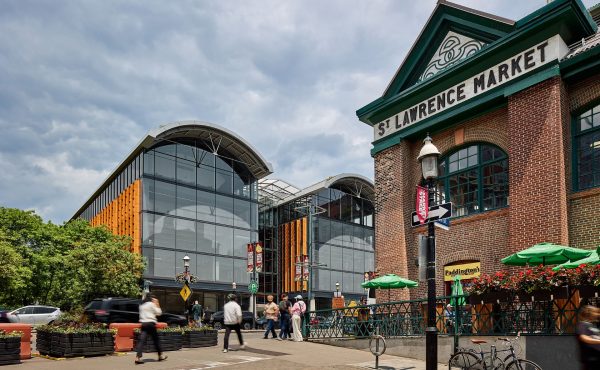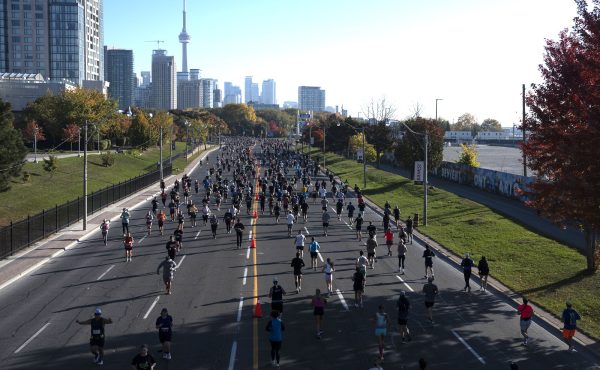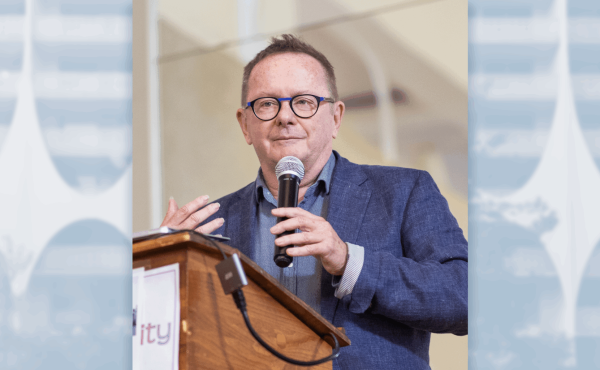
Last week the Heritage Toronto Awards took place at the Carlu. Though we tend to think (often rightfully so) that Toronto tears down its history without a thought, the existance of these awards are a rather impressive achievement itself and indicates there is a fairly large community in Toronto who care about such things. We may take it for granted, but so many other cities don’t have this built-in, grassroots and institutional heritage network. Imagine what would have been lost without their work. It’s also encouraging to see more young(er) folks out at the event who will continue this work in years ahead.
The evening also includes the William Kilbourn Memorial Lecture. This year David Mirvish talked about his father, Ed, and their family’s involvement in Toronto’s Theater scene. Last year architect Bruce Kuwabara talked about the idea of the Urban Palimpsest and how Toronto’s new buildings and developments — its ongoing cultural renaissance — fit in with and overlap on what is already here.
Palimpsest as an urban concept is a place, or site, in which something new is superimposed over traces of something preceding it. The original has been effaced to make room for new writing or in this sense, building. Within this notion of palimpsest, architecture and heritage play a vital role in creating new figures and successive layers of architecture in relationship to what exists. The urban palimpsest is most evident in mature cities, where historic and contemporary architecture are put into visible play. From this perspective, Toronto is a relatively young city, a teenage city, only recently beginning to acquire the density and richness of the urban palimpsest.
—
Toronto is at a unique moment in its history. The interest in architecture, landscape and design has never been greater. City building and the development of the public realm has become the focus of ongoing discussion and lively debate.
—
The Cultural Renaissance has created the most important architectural moment in the city since the 1960’s and 70’s — the last time when global and international forces converged to transform Toronto.
Read the rest of his great speech here.
As for the awards, they are divided into for categories. The winners of the Awards of Excellence are below, but the Merit Award winners and other nominees can be found here. This year, the Architectural award was renamed to honour architect William Greer who has spent 50 years working in Toronto’s conservation movement.
Architectural Conservation and Craftsmanship Category
St. Paul’s Anglican Church, 227 Bloor Street East
 St. Paul’s is three buildings — the “Old Church†(1860), the “New Church†(1913), and “Cody Hall†(1928). The goal of this project was to provide universal access, security and flexibility while transforming the existing heritage buildings into a functional, cohesive facility that retained the historic architectural design. The project involved extensive restoration work on the masonry, roof and stained glass windows of the old church, as well as interior renovations and the intervention of new architecture to join the three buildings into one space.
St. Paul’s is three buildings — the “Old Church†(1860), the “New Church†(1913), and “Cody Hall†(1928). The goal of this project was to provide universal access, security and flexibility while transforming the existing heritage buildings into a functional, cohesive facility that retained the historic architectural design. The project involved extensive restoration work on the masonry, roof and stained glass windows of the old church, as well as interior renovations and the intervention of new architecture to join the three buildings into one space.
Book Category
Inside Toronto: Urban Interiors 1880s to 1920s
 Author Sally Gibson has gathered and researched 260 archival images in her investigation of the complex, interior life of the city. The interior photographs take us from the crowded, plain rooms of the poor in rooming houses to the opulent drawing rooms of the well-to-do, from the factory and shop floor to boardrooms, public halls and private clubs. The photographs are accompanied by a thorough commentary and analysis that help set the images in context and contribute to a better understanding of life in Toronto in that period.
Author Sally Gibson has gathered and researched 260 archival images in her investigation of the complex, interior life of the city. The interior photographs take us from the crowded, plain rooms of the poor in rooming houses to the opulent drawing rooms of the well-to-do, from the factory and shop floor to boardrooms, public halls and private clubs. The photographs are accompanied by a thorough commentary and analysis that help set the images in context and contribute to a better understanding of life in Toronto in that period.
Media Category
The History of Toronto: An 11,000-year Journey Online Publication
 The History of Toronto: An 11,000-year Journey is a skillfully organized and comprehensive online history of the city highlighting the challenges and changes since people first settled in the Toronto area at the end of the last ice age. The written material is enhanced with over 100 images, artifacts and maps covering the period from 9000 BCE to the present day. The user has the option of viewing the full-length publication or a shorter version. Author: Carl Benn
The History of Toronto: An 11,000-year Journey is a skillfully organized and comprehensive online history of the city highlighting the challenges and changes since people first settled in the Toronto area at the end of the last ice age. The written material is enhanced with over 100 images, artifacts and maps covering the period from 9000 BCE to the present day. The user has the option of viewing the full-length publication or a shorter version. Author: Carl Benn
Community Heritage Award (Two winners)
Riverdale Historical Society
 The Riverdale Historical Society was established in 1999 by a group of area residents interested in the preservation of neighbourhood heritage. Since its inception the RHS has hosted 71 events focusing on the history of Riverdale and community heritage. Events have included monthly lectures on a variety of topics, walking tours of the neighbourhood, and visits to Riverdale landmarks and notable homes. The RHS has provided research and funding for plaques commemorating three local landmarks, such as the Don Jail, and is working on several more. Other projects, such as erecting ‘House’ plaques on individual homes and co-sponsoring a Heritage Preservation District study, help to raise awareness of the area’s heritage among local residents.
The Riverdale Historical Society was established in 1999 by a group of area residents interested in the preservation of neighbourhood heritage. Since its inception the RHS has hosted 71 events focusing on the history of Riverdale and community heritage. Events have included monthly lectures on a variety of topics, walking tours of the neighbourhood, and visits to Riverdale landmarks and notable homes. The RHS has provided research and funding for plaques commemorating three local landmarks, such as the Don Jail, and is working on several more. Other projects, such as erecting ‘House’ plaques on individual homes and co-sponsoring a Heritage Preservation District study, help to raise awareness of the area’s heritage among local residents.
The Guild Renaissance Group
 “The Guild†was an arts centre started by Spencer and Rosa Clark in the 1930s. Over the years, the site expanded to include an Inn, as well as extensive gardens housing sculptures, and architectural artifacts from demolished Toronto area buildings. The Guild Renaissance Group was created in 1997 as a citizen’s advocacy group dedicated to the restoration of the cultural landscape of The Guild and the return of arts and crafts programming in the tradition of the Clarks’ “Guild of All Arts.†The GRC has worked at raising awareness about the potential of the site, gathered donations to restore the “Greek†theatre and commented on plans for the development of the Guild. The group publishes a newsletter and leads walking tours of the grounds. For the past two years, the GRC has presented a community arts festival. This year, the event – “Voices of the Guild†– featured a storytelling festival, tours of the gardens, and an artists’ market.
“The Guild†was an arts centre started by Spencer and Rosa Clark in the 1930s. Over the years, the site expanded to include an Inn, as well as extensive gardens housing sculptures, and architectural artifacts from demolished Toronto area buildings. The Guild Renaissance Group was created in 1997 as a citizen’s advocacy group dedicated to the restoration of the cultural landscape of The Guild and the return of arts and crafts programming in the tradition of the Clarks’ “Guild of All Arts.†The GRC has worked at raising awareness about the potential of the site, gathered donations to restore the “Greek†theatre and commented on plans for the development of the Guild. The group publishes a newsletter and leads walking tours of the grounds. For the past two years, the GRC has presented a community arts festival. This year, the event – “Voices of the Guild†– featured a storytelling festival, tours of the gardens, and an artists’ market.
Photo from the collection of Andrew Foot.




3 comments
I’m quite sure that if Bill Kilbourne were giving a speech about heritage before such a large crowd, he’d be excoriating the dreadful waste of the good heritage of the Riverdale Hospital, and lamenting 48 Abell. This lecture has turned into self-congratulating fluffery instead of a more cogent critique of the pressing urban environmental issues that we face.
That said – it is helpful to celebrate some of the good that occurs, but there’s an awful lot that doesn’t get up to the level of the “judges” because it’s too edgy.
We actually thought Bruce’s speech last year was rather “edgy” and one of the better public speeches (in that sort of public intellectual tradition) we’ve seen. That said, more challenging speeches, from establishment platforms, would be great. Though I don’t think we’re at a loss in this city of meeting/charettes/lectures/etc.
The work of the architecture conservationists to save the Riverdale Hospital was recognized with their nomination in community awards. Riverdale Historical Soceity beat ’em out.